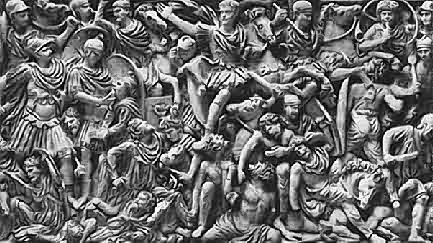
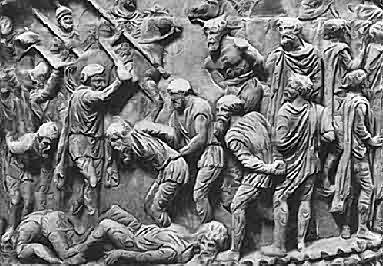
MARCH OF THE TITANS - A HISTORY OF THE WHITE RACE
CHAPTER 15 : ROME AND THE GERMANS
The Germans had settled almost all the land which later became Germany by approximately 2000 BC. They lived a lifestyle very similar to that of the Celts - working iron, textiles, semi-precious stones, ceramics, pottery and gold, and living in villages rather than great towns. Also, like all their Indo-European cousins bar the Balts, the Germans continually made land grabs whenever the opportunity arose.
By 300 BC, they had advanced westwards as far as the Rhine river, and shortly thereafter advance tribes crossed the Rhine and settled what is today Belgium (the Romans called these tribes the Belgae, hence that country's name).
These advances invariably brought the Germans into conflict with the Celts in France, and after the Romans occupied Gaul, with the Romans themselves.
GERMAN ATTACKS ON ROME
Although a German invasion had passed through northern Italy some years before - in 113 BC (and had been eventually been overwhelmingly defeated by the Romans) they still dared from time to time to launch raiding parties into Roman occupied Gaul. In 57 BC, a German tribe, the Saubians, defeated a Celtic tribe in present day Alsace-Lorraine in France, and occupied their territory.
Julius Caesar was forced to intervene to prevent further German incursions. He defeated the German invaders, with the few survivors just managing to escape back across the Rhine River, which was becoming the firm border between Roman Gaul and Germany.
FIRST ROMAN INVASION
In 55 BC, Caesar built a wooden bridge across the Rhine, near to the present day city of Cologne, and over this first ever bridge over that river, he took the war to the Germans in their own territory. Having been beaten several times in a row by the Romans, the Germans withdrew eastward into the forests, leaving the Roman force a virtual free hand to destroy the settlements on the eastern bank of the Rhine river. After just over two weeks of plundering, the Roman army withdrew back over the bridge, declaring all of the western bank of the Rhine to be officially Roman territory.


The Germans proved to the be the only people who were subject to a Roman invasion who actually managed to fight off and defeat the Caesars. Both these reliefs are from the Antoine Column, and show first a Roman unit engaging a German army, and then captured German chiefs being beheaded by Roman soldiers.
SECOND ROMAN INVASION AND THE USE OF GERMAN MERCENARIES
Some two years later, in 53 BC, Caesar again crossed the Rhine and broke the threat of German tribes in Westphalia, eventually even recruiting some German mercenaries to fight with his army which he used to subdue Vercingetorix the Gaul in France.
When Caesar finally subdued the Celts, he then marched on Rome in response to Pompey's call for him to disband his army. Some 6,000 German mercenaries marched with Caesar's army to Rome - the forerunners of many thousands more who would serve in the Roman armies.
This development - the use of German and Celtic mercenaries - would play a hugely significant role in both keeping the Romans out of Germany; and in keeping the Roman Empire alive long after the majority of the original Roman stock had vanished.
After taking power in Rome, Caesar started to try and subdue the still rebellious Celts who lived in the Alps to the north of Italy. It took some 30 years for the Roman legions to finally quell these hardy mountain dwelling people, and afterwards their lands were formerly annexed to Rome.
THIRD ROMAN INVASION
By 15 BC, the formal Roman border extended as far north as the Danube River and as far east as the Rhine - but over that river, still hostile Germans lurked. In 12 BC, the Romans launched a new attempt to invade the German heartland under general Drusus. Although the Germans put up stiff resistance and managed to inflict some major defeats upon the Roman forces, Drusus defeated the major German tribes and in three years managed to reach the Elbe River in central Germany.
Drusus however fell off his horse and died: he was replaced by general Tiberius (who was later to become emperor) and by 7 BC, the new commander of the Roman forces had conquered most of the territory between the Rhine and Weser rivers, and part of the lands beyond the Weser river, inhabited by a tribe known as the Cherusci. The Roman military machine rolled on, unstoppable.
On all fronts, the Germans were either forced to fall back towards the east, over the Elbe River, or faced subjugation by the Romans. It seemed that only a matter of time would pass and the Germans too would suffer the fate of the Gauls in France. Indeed, many of the tactics employed by Caesar in France began to be used against defeated German tribes under Roman control.
HERMANN CHERUSCI - TRAINED BY THE ROMANS
However, the by now established Roman policy of drawing subjugated peoples into the administration of their own territories, thereby not only Romanizing the population but also going a long way to subduing the new colonies, was also implemented in Germany. In this way two young Cherusci princes, the sons of the king of the Cherusci, were selected to be Romanized. Both young princes were sent to Rome in 1 AD.
One of the brothers became completely Romanized and took on the name Flavius, while the other kept his German name, Hermann, although the Romans gave him a new name as well: Arminius. Hermann served five years in a Roman legion, becoming a Roman citizen and employed on active service in two expeditions against other rebellious colonies. But all the while, he always retained his German roots, unlike his brother.
When Hermann was returned to his native area in 8 AD, he was employed by the Roman administration as one of their most senior soldiers and administrators in the region under the Roman general Varus: never once did the Romans suspect Hermann's true intentions, which were to throw the Romans out of his homeland.


Left: The famous "Praying German" - a Roman statue of a German tribesman, now in the Bibliotheque Nationale, Paris. It shows very clearly the Nordic sub-racial characteristics of the Germans who fought the Romans. Right: a Roman bust of Hermann Cheruscer: the German prince who defeated Rome.
BATTLE OF TEUTORBURGERWALD - DECISIVE DEFEAT FOR ROME
As soon as he was in a position to act, Hermann immediately set about organizing a rebellion amongst the Germans against Roman rule. Using his position as a German prince to influence a large number of German tribes, Hermann secretly began preparing his own great German army - no doubt using much of what he had learned during his training in the Roman army.
In 9 AD, Varus' Roman army was encamped west of the Weser river in the modern day German state of North Rhine Westphalia. Hermann arranged to have a diversionary battle erupt to the east, and Varus immediately set off in that direction.
Hermann put his plan into action. Gathering up the German troops in the Roman army upon whom he could rely, and combining it with German tribal warriors, he set out in pursuit of Varus, catching up with the unsuspecting Roman in the thick of the Teutoburger forest, near the present day town of Detmold.
In the forest, Hermann's forces ambushed the Romans. For three days the battle raged, with Hermann employing unusual guerrilla tactics, attacking and then suddenly withdrawing into the forest before the Romans could create their set battle formations, and then attacking again a while later from a completely different direction.
Hermann knew from his training in the Roman Army that the Romans did not have an adequate defense against this tactic, and after three days the Romans were exhausted. No sleep, constant attacks by German raiders and unfamiliar territory took their toll and the Roman lines broke.
Only a handful of Romans escaped from the forest to tell the tale. Most were killed in combat and those who were captured suffered the fate of many Germans and Celts who had earlier fallen into Roman hands - they were killed on the spot. News of the victory spread throughout occupied Germany, sparking off a rebellion which saw the Romans having to retreat all the way back to the western side of the Rhine river once again.
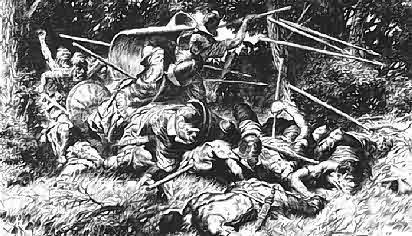
A skirmish during the Battle of Teutoburgerwald, where the Germans under Hermann Cherusci defeated a mighty Roman army. This 9 AD battle marked the turning point of the Roman Empire in the West. Hermann was a Romanized German who, once appointed to a senior post in the Roman army, used his position as a German prince to organize a rebellion against Roman rule in Germany. After creating a diversion and tricking the main occupying Roman army into penetrating a forest near the present day city of Detmold, Hermann's forces ambushed the Romans in the dense woods. The Romans were crushed, and retreated west over the Rhine river. That river then became the German/Roman border. 15,000 Roman troops were killed in the battle and their remains were only buried long after by a new Roman army sent on a punitive mission - their accounts tell of piles of bleached bones and skulls nailed to trees as macabre warnings to other Romans.
Although the wars with the Germans dragged on for eight
more years, by 17 AD, the Romans formerly accepted the Rhine as the border between Germany
and Rome. Germany was never invaded again.
Hermann had also succeeded in at last uniting the German tribes against Rome. This unity
was however short lived and once the Romans had been driven from their land, the German
tribes lost little time in launching into one another again. Hermann himself was
assassinated in 21 AD - by a German.
Thus Germany once again became a land of fierce and warlike tribes, all battling with each
other for territory as they had done before the advent of the Roman incursions.
"A PURE AND UNMIXED RACE" - THE GERMANS
The Roman historian Tacitus, writing during the First Century AD, included the following insightful remarks on the racial nature of the Germans:
"I concur in opinion with those who deem the Germans never to have intermarried with other nations but to be a pure and unmixed race, stamped with a distinct character.
"Hence, a family likeness pervades the whole, though their numbers are great. Their eyes are stern and blue, their hair ruddy, and their bodies large..."

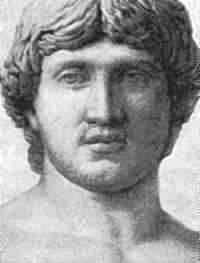
Original Roman statues of Germans, displaying Nordic and part Nordic/part Alpine characteristics.
In what became a major twist of irony, Rome itself from the first century onwards began to rely more and more on German and Celtic mercenaries to fill the ranks of its armies.
The cause of this reliance on mercenaries is directly related to the demographic changes at work within Italy itself. Rome, with its status as capital of the Empire, had acted as a magnet for not only slaves but also immigrants from all over the world, and particularly from the Middle and Near East.
ROME INCREASINGLY MIXED
Although the Roman nobility still to a large extent maintained its original racial heritage (mixed Nordic/Alpine/Mediterranean), their numbers began to decline significantly. This was due in part to their use of lead water pipes and sapa (lead acetate) as a skin lightener - a valuable racial indicator in itself. The high lead intake had the side effect of sterility, an issue which is noted as having plagued the Roman upper classes.
The lower classes of Roman society - Rome was very class conscious - had by the end of the 2nd Century AD, reached a point where a significant number had been replaced by what were in effect mixed or Nonwhite racial types gathered from the four corners of the empire.
In his book, the Gallic Wars, Caesar, who was himself a Nordic type, compared the Romans of that time with the Gauls, remarking how blond the Gauls were and, in comparison with the Romans, how tall they were. (Caesar went on to describe Celts in Britain as being blond, but not as much so as their Celtic brethren in Gaul). This is not to say that Rome of this time was a completely Nonwhite city - there remained of course a large number of Whites in the city, but the demographic trend was most certainly against them.
By the end of the first century and the beginning of the 2nd Century AD, the Roman army found the number of recruits from these "new" Roman residents drying up. A huge number of residents of Rome were after all foreign, even though they had taken on the ways of Rome, and either refused to serve in the army; or were simply not up to the exacting physical demands - or, more likely, preferred mercantile pursuits rather than the rigor of a military life.
GERMAN AND CELTIC MERCENARIES FILL THE RANKS OF THE ROMAN ARMY
The Germans and Celts ended up therefore being the primary source of recruits for the Roman armies - not surprisingly so, as in racial terms they were much closer to the original Romans than the majority of inhabitants of Rome itself, particularly from the 2nd Century AD onwards.
By the time of the end of Caesar's conquests of the Celts, the Roman records show that the average height of the Roman soldier had been lowered to 1.48 meters.
As the numbers of German and Celtic mercenaries increased in the Roman army, the average height began to rise - by 300 AD it had risen to 1.65 meters - an indication that the racial types of the average soldier had changed fairly substantially.
So it was that the Roman armies began to fill up with non Roman soldiers, with Romanized Germans and Celts forming a significant - if not the majority - of not only the foot soldiers but also of the commanding officers. These Romanized Germans and Celts were to play a significant role in the remaining years of the Western Roman empire: and it was they, predictably, who formed the backbone of the resistance to the last German invasions which saw the final physical fall of Rome.
A Romanized German soldier was in fact the last (self declared) Emperor in Rome. By that date (476 AD) the last true original Romans had to all practical purposes disappeared, having been swallowed up in a mass of immigrants from the Nonwhite regions of the empire.
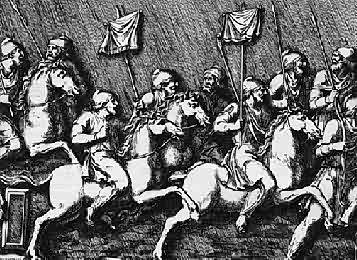
German mercenaries in the Roman army, as depicted on the Colonna Antonia in Rome. Within a relatively short space of time the Roman army began to rely heavily on German mercenaries to fill its ranks as White Roman numbers declined.
NEW GERMANIC INVASIONS - FRANKS, SAXONS
In the second century AD, German tribes went on the offensive against Rome and crossed the Danube. They were however bloodily defeated by a Roman army which had a significant number of these German and Celtic mercenaries in it, led by Marcus Aurelius. During the third and fourth centuries, German tribes called the Franks and the Saxons raided Roman settlements in France and Britain respectively. These smaller incursions continued until the final chapter in the saga of the German - Roman wars was to be written by the last of the Indo-European tribes to enter Europe - the Goths.
or back to
or
All material (c) copyright Ostara Publications, 1999.
Re-use for commercial purposes strictly forbidden.